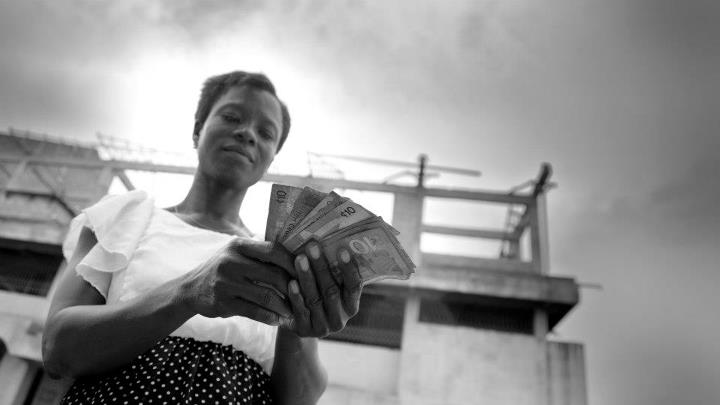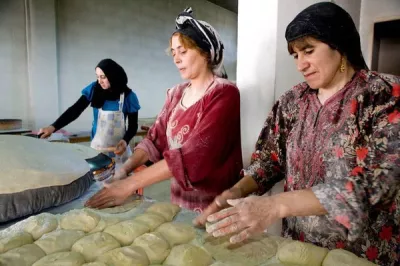A National Experiment: Sharia-Compliant Finance in Sudan
In many countries with large numbers of poor Muslims, Sharia-compliant microfinance is one among many interventions designed to bring citizens into the financial mainstream.
This is not the case in Sudan. Here, Sharia-compliant microfinance is the government-mandated rule, not the exception. That’s because the country’s banking system went fully Islamic in the 1980s, legislating Sharia principles like risk-sharing, leasing, and interest-free “loans.”
So how has this national experiment fared? And what can Sudan teach us about how to make Sharia-compliant microfinance viable?
 A woman counts bills.
A woman counts bills.
Photo Credit: Jay Bendixen
First, adapt the system
By the time microfinance began attracting global attention from policy makers for its potential to alleviate endemic poverty, the Central Bank of Sudan already had more than a decade of experience regulating Islamic banking.
But policy makers also knew what they didn’t know—how to reach poorer clients, especially in rural areas where the costs of establishing a bank branch, let alone vetting and tracking potential customers with little or no collateral or credit history, seemed prohibitively expensive.
They also knew that other countries had figured out how to cut costs and nurture sustainable microfinance institutions that were serving ever-larger numbers of poor people. Keen to understand how, the central bank commissioned a demand and supply study of microfinance in 2006, the results of which—coupled with consultations with civil society, government, and other leaders—became the national strategy for the development and expansion of the microfinance Sector in Sudan.
A year later, in 2007, the Central Bank of Sudan established a dedicated microfinance unit tasked with implementing the strategy’s cross-cutting recommendations, namely to foster a conducive policy environment, a regulatory framework geared toward market-driven financial services, and the intellectual, human, and financial capital to provide those services effectively.
Next, get the products right
Although much of Islamic banking has revolved around consumer lending, policymakers in Sudan knew that microfinance clients, many of whom lack collateral or even a steady income, needed products that would help them kick-start or sustain income-generating activity.
For the former group, in particular, the Central Bank zeroed in on two profit- and loss-sharing schemes: musharaka and mudaraba. In the first, the financier provides equity financing to a project while in the second, the financier provides all the funds for an entrepreneurial activity while expecting the client to provide managerial expertise.
And for those potential clients who were already engaged in income-generating activity—mainly farmers—the Central Bank set out to provide salam financing, which essentially provides advance payment against future delivery.
Other products for the economically active poor included murabaha, a cost-plus-markup contract on working capital goods, and istisna’, which defers delivery of mainly manufacturing supplies until clients have paid off the assets in fixed installments.
Finally, roll out the strategy—and measure progress
Getting these products to the market meant enlisting banks and other financial service providers in the effort. To ensure their participation, the Central Bank in 2008 issued a series of “circulars” requiring banks to channel at least 12% of their total loan portfolio toward microfinance clients.
At the same time, microfinance institutions needed more guidance on how to manage risk, thereby serving their current clients more reliably while expanding outreach to new clients. Careful not to create too many barriers to growth, regulators required microfinance institutions to seek licensing in three steps, which included a minimum equity participation that was pro-rated for institutions working only at the state or local levels. (Those working at the national level had an equity retirement of 1 million Sudanese Pounds, or roughly $227,000, while those working only locally were required to show just under $70,000 equity participation).
Of course, deposit-taking institutions were also subject to prudential supervision, and in all cases, microfinance providers had to devise five-year business plans and policy manuals as well as institute a loan tracking system and regular internal and external audits.
Still, that wasn’t enough. These institutions needed access to funds. In 2008, the Sudan Microfinance Development Facility was established as the first apex institution in Sudan, funded by the Central Bank and multi-donors trust fund, and committed to providing equity participation, wholesale lending, and technical assistance.
Have these efforts paid off?
Since 2006, when the government started taking the Islamic banking sector “down-market,” 10 microfinance institutions have entered the market and remain viable, 12 banks have established microfinance “windows,” and five insurance companies have introduced “micro” products for poor clients.
Out of this have emerged several exciting programs that are offering early evidence that the country’s strategy is paying off. One such initiative, launched in partnership with the World Food Program in 2010, began by linking 3,000 farmers in three Sudanese states to markets and sources of financing. In 2012, that program had grown to serve 150,000 farmers in nine states—a 50 fold increase.
A similar program is yielding results in North Kurdufan, where 27,000 farmers in 61 villages have increased hibiscus production with the help of financing and new market linkages—all thanks to the efforts of local organizations that are helping bridge the gap between good income-generating ideas and the financing to make them a reality.
Though these early results are cause for optimism, we in Sudan also need to better understand which of the Sharia-compliant microfinance products are working—and why. By deepening our learning, we can invest in the right products going forward, thus expanding outreach to hundreds of thousands more.
---- The author is the CEO of Leaders of Change for Consultancy & Training and the former President of Microfinance Unit, Central Bank of Sudan.




Comments
One of the positive features
One of the positive features of sharia compliant products referred to her is certainty in loan utilization productively for income generation by sharing the risk by both the lender and clients. Unlike MFI lending to the poor without certainty on end use of loan with too may assumptions in the demand side, theses products stand unique and client value based one.
How ever there are two concerns here 1) it appears only economically active poor and potential farmers are included excluding the ‘others’ the poorer (as referred to in the post)in the pyramid. How the complexities of graduation of the ‘Others’ are challenged in Islamic finance? 2) In the context of loss due to co variant risks affecting farming and the enterprises , why micro insurance is not referred in these products ? 3) Need for qualitative M&E with clarity on the term “ the poor clients” and for capturing the profile of the clients for judging the extent of deepening of inclusion and exclusion in the pyramid
Dr Rengarajan
Add new comment